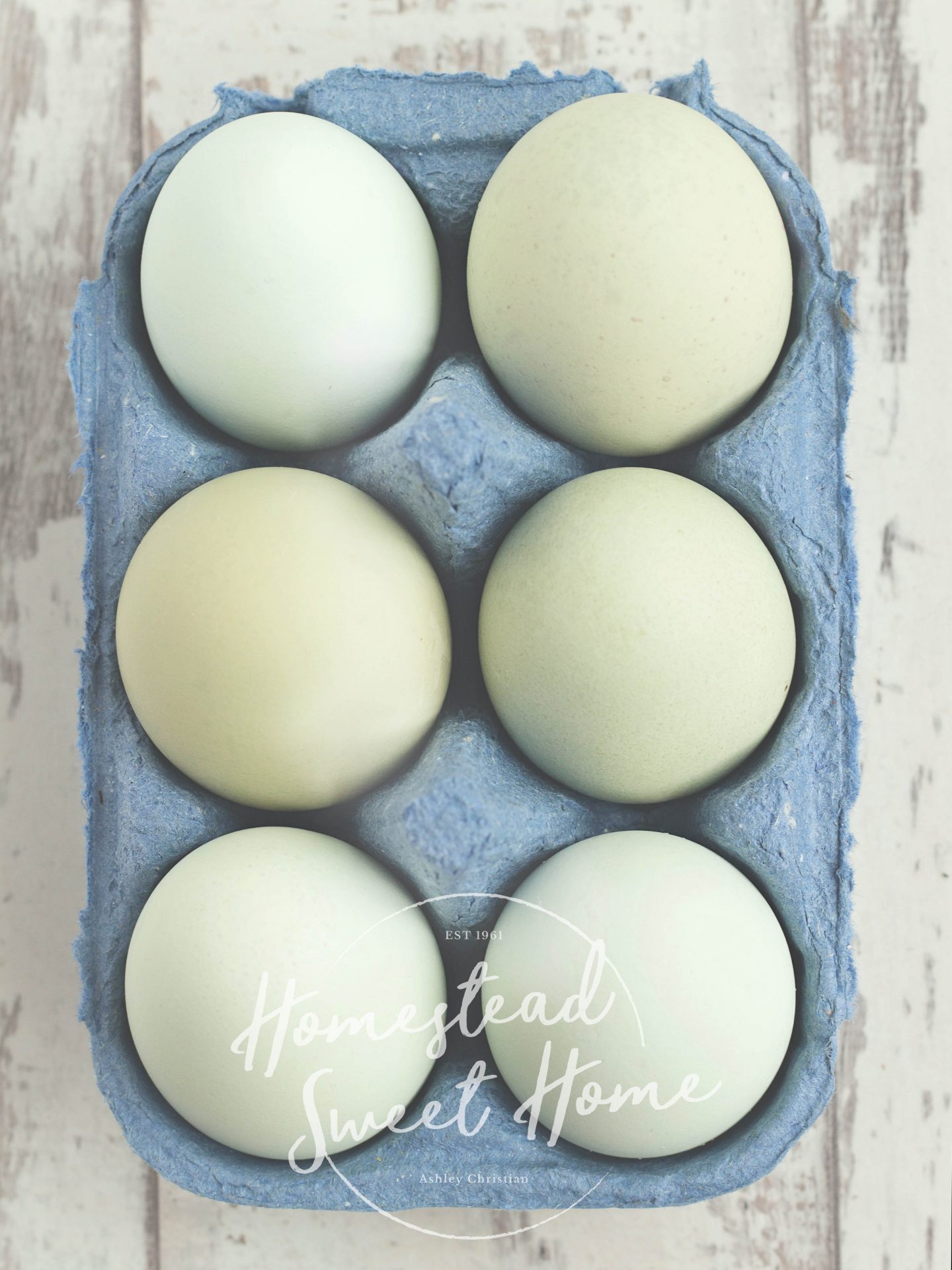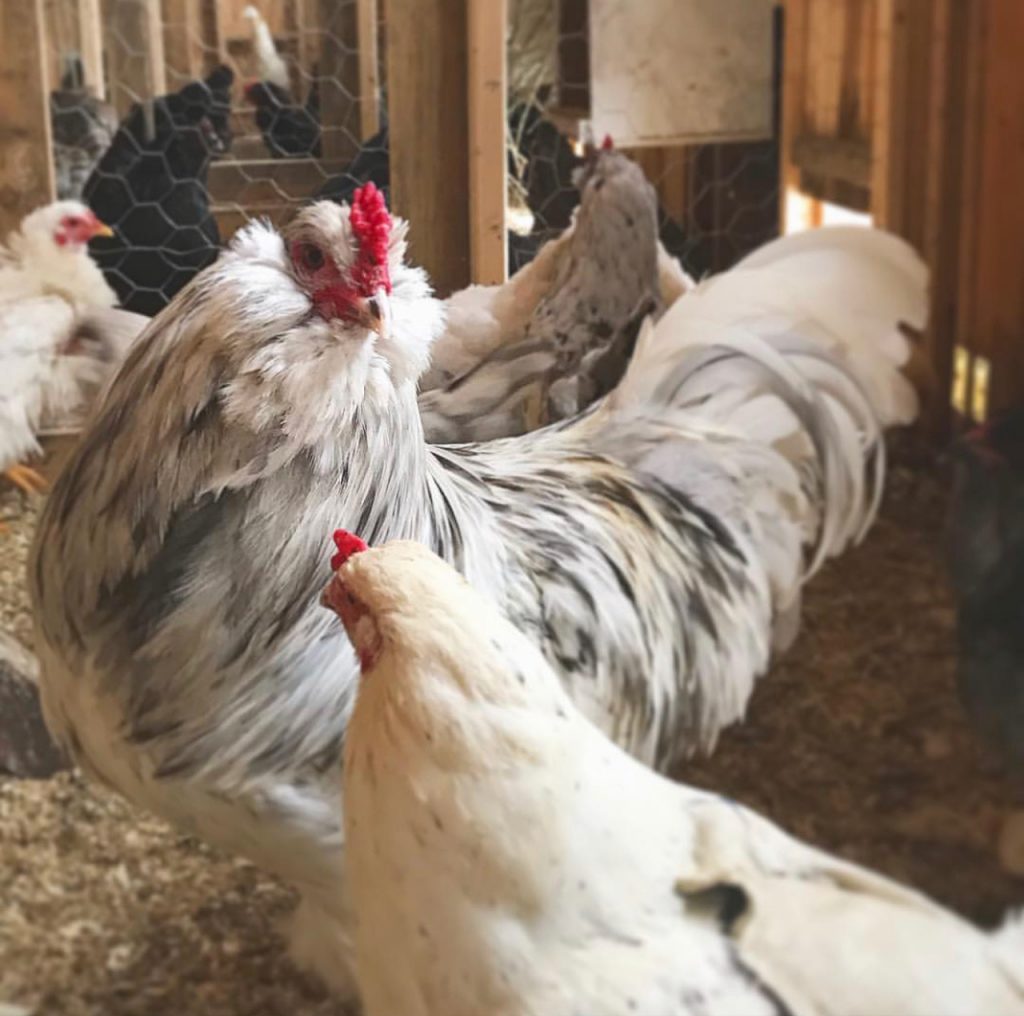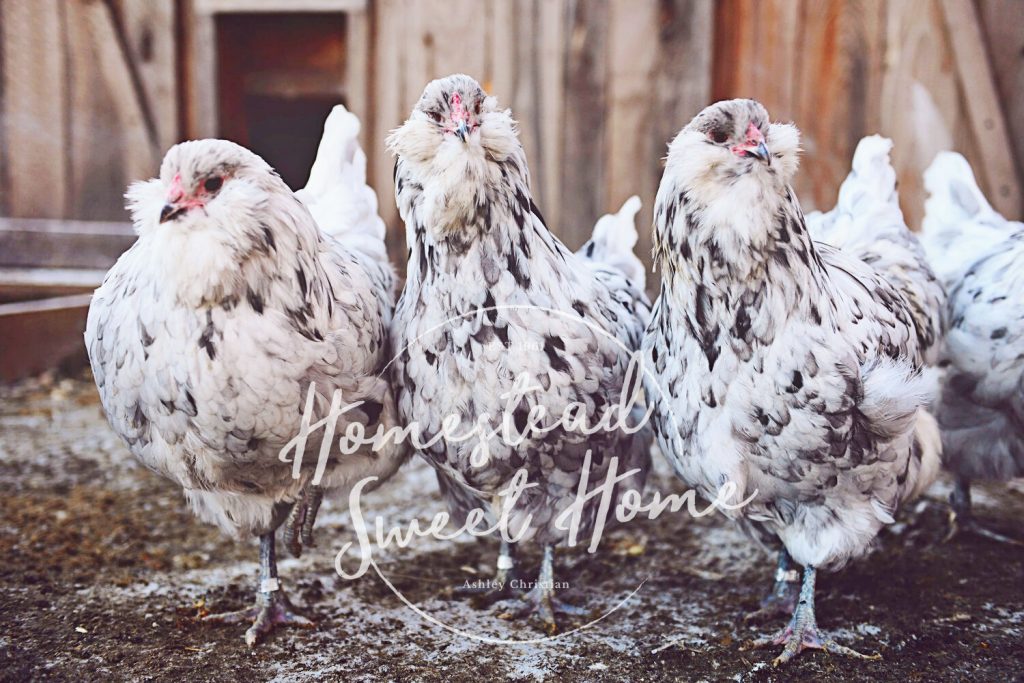Ameraucana Chicken – Is Your Blue Egg Layer Pure-bred?

Ameraucana Chicken Quick Facts
- Known for: their beautiful light blue eggs, winter hardiness, hawk-like appearance, and good predator evasion
- Temperament: friendly, docile, calm, not very cuddly, flighty, good forager
- Eggs: 150 large blue eggs each year
- Meat: poor—reaches maturity at 22 weeks with 7 lb males and 4 lb females
- Climate: good heat and cold tolerance
- Broodiness: not very likely to sit on their eggs
Ameraucana Chicken Overview
The Ameraucan chicken is so unique because of its beautiful blue eggs. The chickens come in a variety of colors but the eggs from a good breeder or reputable hatchery are very true to their color.
These are medium-sized birds that make a decent dual-purpose breed with meat and eggs. They are very winter hardy which can help them lay through the winter.
They are a calm, docile breed, but not cuddly and don’t particularly like to be held. They end up somewhere in the middle of the pecking order. Their medium size and hawk-like appearance help them to be good foragers and predator savvy.
Pros and Cons of Ameraucana Chickens
- Pros: exquisite blue eggs, intelligent breed, friendly when handled frequently from hatching, good foragers, and predator savvy
- Cons: loud, not a great winter layer, can be skittish and flighty, slower to mature, will sometimes peck other birds
Ameraucana Chicken Appearance
Size: medium-sized birds 4 lb females and 7 lb males
Colors: they come in a large variety of feather colors including black, blue wheaten, wheaten, buff, brown-red, silver, and white.
Egg Color: incredible large light blue eggs
The Ameraucan can come in a large variety of feather colors, but all have a hawk-like appearance, an interesting beard and muff, and reddish eyes.
Ameraucana chickens are not easy to sex, so it is difficult to tell the pullets and cockerels apart until they reach sexual maturity at 22 weeks. For many, the first giveaway is when the roosters begin to crow.

Ameraucana Chicken Egg Production
Ameraucan chickens are decent egg layers and will lay about 150 large beautiful blue eggs per year. Even though they are winter hardy birds, they usually will stop laying in the winter months, which is what decreases their yearly egg production.
Because the Ameraucan chicken is slower to develop, they take longer to begin laying. They reach sexual maturity at 22 weeks, but many do not start laying until they are 5 to 7 months old.
To keep your birds healthy and productive, keep their coop and run clean. You can also give them a separate bowl of oyster shells or crushed eggshells to consume as desired. These supplements will provide the extra calcium they require to lay eggs as well as possible.
Their large blue eggs have the same nutritional value and taste as white and brown eggs.
Ameraucana Chicken Meat Production
The Ameraucana can certainly be used for meat, but the dressed birds will be small and nothing compared to other dual-purpose or hybrid meat birds. The main reason you’d want to butcher Ameraucanas is to cull unwanted roosters.
These chickens are relatively slow growers and will reach maturity around 22 weeks, or 5 to 7 months. You can also let them continue growing to get the most meat possible and butcher at 7 to 8 months old. After around 9 to 10 months, your chickens will become less tender and will be best used as stew meat or chicken stock.
Ameraucana Chicken Broodiness
Ameraucana chickens very rarely go broody. If you want to hatch fertilized Ameraucana chicken eggs yourself, you can purchase an incubator that automatically turns your eggs, and controls the temperature and some models even control the humidity. There is nothing quite as special as watching chicks hatch, especially from blue eggs! If you have a broody hen from another breed or a Silkie chicken, you can always slip some blue eggs under her.
Ameraucana Chicken Temperament
Ameraucan chickens are friendly and docile birds, especially when handled regularly from hatching. They are not known for cuddling and being petted and are a more independent bird. This can be a good thing as less “tame” birds are often better foragers and are more predator savvy.
The Ameraucan chicken is fast, flighty, and loves to forage and chase after bugs. They are a medium-sized bird so they can easily fly into trees to roost or protect themselves from predators. Their hawk-like appearance is said to deter predators as well.
Ameraucana chickens are said to be skittish by many of their owners, which is typical for more flighty, less tame birds. If you raise them as chicks and handle them often they will be more friendly. The trade-off for their skittishness is they are alert for predators. And of course, there are their amazing blue eggs which is the real prize.

Ameraucana Chicken Noise Level
Most Ameraucan owners say their chickens are pretty loud. They aren’t the loudest chicken breed there is, but I wouldn’t say they’re quiet either. This is something to keep in mind if you live in a neighborhood or urban area. If your neighbors are open to it, you might be able to sweeten the deal with some beautiful blue eggs to share.
Ameraucana Chicken Care
Ameraucana chickens are thankfully hardy and free of disease or breed problems. Much unlike their ancestors the Araucana chicken, who had a genetic ear tuft trait that could be lethal.
Because the Ameraucana is so predator savvy, they often outlive other breeds of chicken and can live an average of 7 to 8 years. As with all chickens, you will want to keep the coop and run clean and free of manure build-up and soiled bedding. Get your chicks vaccinated or use medicated chick starter, and put a few teaspoons of apple cider vinegar in their plastic waterer to boost their immune systems.
Because the Ameraucan chicken is such an active breed, they will do well with space to free-range. This is not a bird that will be happy in close confinement.
To learn more about how to take care of your Ameraucana chickens, read our Ultimate Guide to Taking Care of Chickens.
Ameraucana Chicken Housing
Ameraucana chickens need four square feet each inside their coop, and fifteen square feet each in their run. Ideally, you will free-range your Ameraucana chickens. If you aren’t able to let them freely forage, an extra-large run or a chicken tractor would be best.
Provide a roost in the coop for your chickens at night as Ameraucan chickens are flighty birds and will love to roost up high. Your hens will need about one nesting box for every three hens so they don’t get too crowded and their nesting boxes should be about 12×12.
If you decide to keep your Ameraucana chickens in an enclosed run, it will help you to keep predator netting over top, not as much to keep aerial predators out but to keep your Ameraucana chickens in. They are lightweight, flighty birds that can easily fly into trees to roost, or even on the roof of the coop.

Feeding Ameraucana Chickens
Ameraucana chickens can be given standard chick starter from hatching till they reach maturity around 20 weeks. Layer feed contains 16% protein and added calcium to keep their eggshells healthy and strong. Roosters can eat the same feed as the hens.
You should give your Ameraucana chickens as much free-roaming space to eat plants and bugs as you can provide. They’ll also enjoy kitchen scraps (though there are some that are harmful, so avoid avocados, dried beans, junk or rotten food, green potato skins, citrus, onions, or tomato or potato leaves from the garden.) Giving them this variety will not only help you save money on the feed but will also keep them healthy and entertained.
Offering confined Ameraucan chickens grit is important for their health. Since chickens don’t have teeth, they need fine gravel or coarse sand in their gizzards to digest their food. Free-range chickens can usually naturally find this, but if your Ameraucan chickens don’t have access to pebbles, sand, or fine gravel, you’ll want to offer some supplemental grit.
Chicken Treats: You don’t HAVE to give your Ameraucan chickens treats, but it’s a lot of fun! Mealworm and black soldier fly larva treats are excellent snacks for chickens that you can get from the feed store. Treats may be helpful in taming your Ameraucan chickens and encouraging them to grow accustomed to you.
What is it like to own an Ameraucana Chicken?
Ameraucana chickens lay the most lovely blue eggs, which is the main draw for most Ameraucan keepers. They don’t lay well through the winter, and hardly go broody.
They are friendly chickens but can be skittish as well. They are very active, full of personality, and fun to watch, especially when they are out chasing bugs or flying into trees.
Ameraucana chickens can display a wide variety of personality traits. For some they are sweet and easily handled, for others they are skittish and aggressive toward smaller chickens. A lot of their personality really depends on their particular bloodline, and the conditions they are raised in.
We’ve said it before, but the more you can handle your Ameraucana’s as chicks, the more friendly they will be. If you are keeping a mixed flock of other chicken breeds, your Ameraucana’s temperament towards them will also depend on how dominant or submissive the other chickens are. For some the Ameraucana is the bully, for others, it is bullied, and others say they get along well with the flock.
You are never totally sure what sort of personality traits you will get from your Ameraucana chickens, but one thing we do know for sure, they will give you those wonderful blue eggs. Part of the wide variety of personality traits seen in the Ameraucana chicken by their owners may be the fact that it is a rare breed and often what these owners actually have is a hybrid Easter Egger chicken that is being sold under pretense as a pure Ameraucana.
Ameraucana Chicken Breed History
The ancestor of the Ameraucana chicken is the Araucana chicken, which began in Chili and was of Asian origin. The Araucana was not a true breed, but rather a mix of breeds that had an unfortunate genetic defect in 20% of its offspring that led to death.
The Ameraucana is America’s newest breed and was accepted into the American Poultry Association in 1984. It is still a relatively rare breed of chicken and is mainly kept for hobby purposes rather than for being an excellent egg-layer or meat producer.
It is important to understand that some breeders and hatcheries will call their Easter Egger chickens, which lay green eggs or mixed colored eggs, Ameraucanas, even though they are not Ameraucana chickens. If you’re looking for specifically blue eggs, or desire to show Ameraucanas, you’ll need to verify your chicken’s true breed with your hatchery or breeder.
An Ameraucana chicken has been accepted into the APA whereas the Easter Egger chicken has not, so it’s not technically a breed and can go by many different names. Watch out for strange spellings of Ameraucana’s that are actually Easter Eggers (EE’s) like Americana, Ameracauna, Americauna, Ameracana, or Ameruacana.
Another way to tell if you have a purebred Ameraucana is the price. Easter Eggs will cost $5 to $10 a chick while pure Ameraucana will cost around $20 a chick. Also if you see a notice from the hatchery that says “not for 4-H, FFA, or exhibition use” that’s another sure sign it’s not pure.
An Easter Egger is a hybrid bird, and while they are wonderful birds, it’s important to know what you’re getting.
Summary
Though the Ameraucana chicken is not as sweet and cuddly as other breeds of chicken, their beautiful blue eggs more than make up for their independent personalities. Their independence also makes them excellent foragers and more predator savvy than most chickens.
They are not great meat birds, and often do not lay through the winter, but if you love the idea of unique blue eggs, you will thoroughly enjoy your Ameraucana chickens.
Do you own Ameraucana chickens? Let us know in the comments below what your experience has been.

Leave a Reply